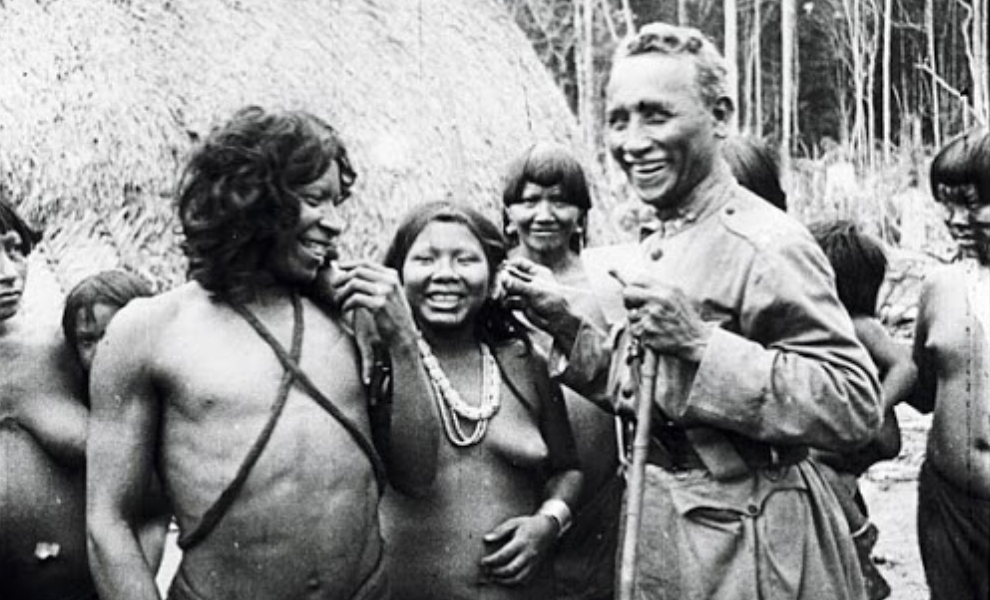When Brazil entered World War II, President Getúlio Vargas decided to slice up Brazil’s border regions into separate states as a matter of national security. Parts of the massive north and western expanses of Amazonas, Pará, and Mato Grosso were turned into the new federal bodies of Amapá, Roraima, and Guaporé. In 1956, a vote in Congress changed the name of the latter, making it the only state named in an individual’s honor: Guaporé became Rondônia, in homage to Army Field Marshal Cândido Rondon.
While there are no shortages of cities, roads, and bridges named after members of Brazil’s Armed Forces — many of them with less-than-honorable pasts during the country’s military dictatorship period — the case of Cândido Rondon was a very different one.
Marechal Rondon, as he is known in Brazil, was a pioneer in protecting the country’s indigenous communities, helping to create the Indian Protection Service (SPI) in 1910, which later became Brazilian Indigenous Foundation (Funai) that still functions today.
Rondon introduced a whole new conception of how the Armed Forces (and Brazil as a whole) should approach indigenous communities. For the longest time, the military viewed uncontacted tribes as potential threats. Expeditions into Brazil’s interior sought to “tame” indigenous people and enslave them for labor. Those who refused were “just as much our enemies as the English, Dutch, or French.”
This changed under the tutelage of Marechal Rondon. In the 1890s, the field marshal led an expedition into the province of Amazonas to explore previously uncharted territory, protect Brazil’s borders, and build telegraph lines to connect the region to the rest of the country. Fueled by positivist ideals, the so-called Rondon Commission made contact with dozens of indigenous tribes along the way, treating these previously isolated communities with a humanistic and sympathetic approach ignored by his predecessors.
Rondon had a strict procedure for making contact with a new indigenous group. First, the members of the expedition would issue presents to the tribe, such as hunting knives and other useful implements. Then, in the second phase, known as “courting,” the troops would wait until the indigenous community reciprocated with presents of their own, as a sign of good faith.
The third step came once the members of the tribe invited the explorers to visit their village, and the fourth phase consisted of the two parties establishing a pact of non-violence. Finally, the “pacified” indigenous people were taken to nearby medical outposts, where they received food, medication, and were taught basic agricultural methods.
Throughout this entire process of approximation, Rondon had an unwavering credo, which he demanded all of his colleagues abide by: “die if you must, but never kill.”
This motto was adopted by the SPI and, indeed, dozens of employees ended up losing their lives by following Rondon’s directive to the letter.

Problems along the way
Despite Rondon’s humanistic approach toward indigenous communities, the road toward encountering tribes, “pacifying” them, and offering them protections was fraught with controversy. During the 20th century, there were countless reports of entire villages perishing during contact with SPI officials, due to error or negligence. The most common issue concerned respiratory disease, with cases of explorers arriving while carrying flu symptoms that quickly ravaged the previously uncontacted tribes.
And the ultimate goal of the SPI had never been completely in line with Rondon’s teachings. Created as a subordinate of the Agriculture Ministry, it was originally called the Indian Protection and Localization of Brazilian Workers Service, with the objective of integrating indigenous people into the Brazilian population as rural workers or farmers.
What’s more, after the military coup of 1964, even Rondon’s sympathetic “die if you must, but never kill” mantra was tossed aside.
The bloodsoaked history of the military dictatorship
The military government’s attitude toward the Amazon was much closer to that of the pre-Rondon imperial era, by which the region was to be “occupied” as a matter of national security and territorial expansion, with no regard for the livelihood (or lives) of the indigenous communities which called it their ancestral home.
In his 2017 book “Os Fuzis e as Flechas” (The Rifles and the Arrows), journalist Rubens Valente writes that the newly installed government hatched a series of plans to “take control” of the Amazon region. One such idea involved building a dam in the Amazon River, flooding huge swathes of Brazil’s North — including the modern day cities of Manaus and Santarém — to create “a true Amazon sea, allowing large-scale navigation.”
The chosen strategy was laid out in the government’s “Operation Amazônia” in 1966, of which one of the pillars was to attract the “civilized” population of the South and Southeast to move to the North and set up shop, in exchange for massive tax cuts, imitating a similar program put in place for the country’s poor Northeast.
Migrants flooded to the region and until today, many of the major landowners in Rondônia and surrounding areas hail from the southern states of Paraná and Santa Catarina — even the Rondônia accent now carries a distinct southern twang.
While this contributed to the economic development of the region, at no point in the program was any attention given to protecting the indigenous communities that already lived in the North. In a 45-page document produced by the dictatorship’s National Security Council — then led by future military President Emílio Garrastazu Médici — the administration laid out its national security strategy, involving the occupation of lands in the Amazon to further economic growth.
The entire dossier made not a single mention of indigenous people.[/restricted]










 Search
Search






































